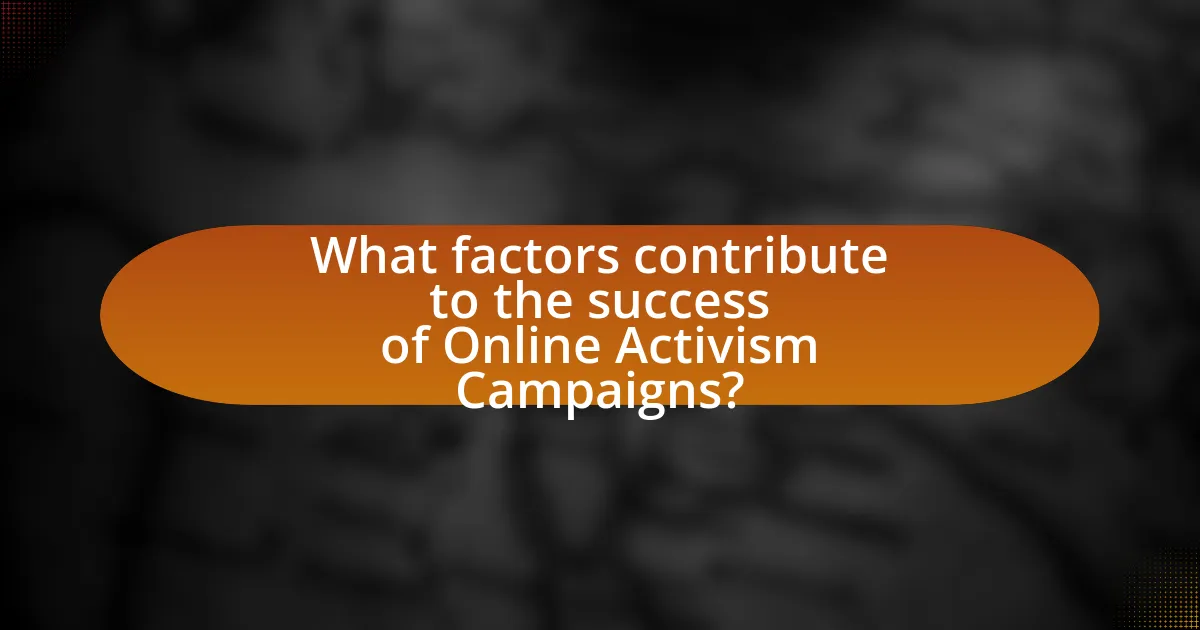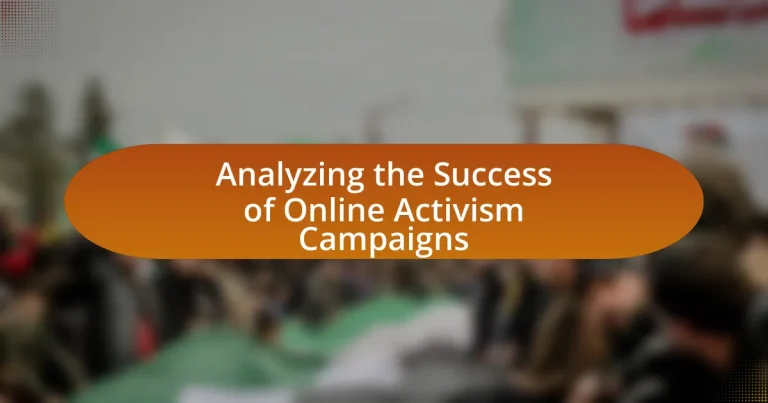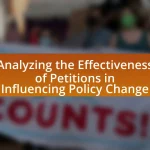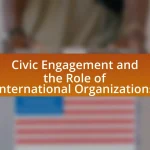Online activism campaigns are organized efforts conducted through digital platforms aimed at promoting social, political, or environmental change. This article analyzes the mechanisms, strategies, and platforms that underpin the success of these campaigns, highlighting their importance in mobilizing support and influencing public opinion. Key factors contributing to their effectiveness include audience engagement, clear messaging, and the strategic use of social media. Additionally, the article addresses challenges such as misinformation and digital privacy, while outlining best practices for enhancing campaign impact and ensuring transparency and accountability.

What are Online Activism Campaigns?
Online activism campaigns are organized efforts conducted primarily through digital platforms to promote social, political, or environmental change. These campaigns leverage social media, websites, and online petitions to mobilize support, raise awareness, and influence public opinion or policy. For instance, the Ice Bucket Challenge in 2014 raised over $115 million for ALS research, demonstrating the significant impact online activism can have on fundraising and awareness.
How do Online Activism Campaigns function?
Online activism campaigns function by leveraging digital platforms to mobilize individuals around social or political causes. These campaigns utilize social media, websites, and email to disseminate information, raise awareness, and encourage participation through actions such as signing petitions, sharing content, or attending events. For example, the Ice Bucket Challenge in 2014 raised over $115 million for ALS research by encouraging participants to share videos of themselves pouring ice water over their heads, effectively combining entertainment with a charitable cause. This demonstrates how online activism can create viral engagement, leading to significant financial and social impact.
What platforms are commonly used for Online Activism Campaigns?
Common platforms used for online activism campaigns include social media networks like Facebook, Twitter, Instagram, and TikTok, as well as crowdfunding sites like GoFundMe and Change.org for petitions. These platforms facilitate widespread engagement and mobilization, allowing activists to reach large audiences quickly. For instance, a study by the Pew Research Center in 2021 indicated that 69% of adults in the U.S. use Facebook, making it a vital tool for organizing and promoting activism. Additionally, Twitter’s character limit encourages concise messaging, which is effective for rallying support and sharing updates rapidly.
What strategies are employed in Online Activism Campaigns?
Online activism campaigns employ strategies such as social media mobilization, targeted messaging, and coalition building. Social media mobilization leverages platforms like Twitter and Facebook to reach a broad audience quickly, facilitating rapid dissemination of information and calls to action. Targeted messaging focuses on specific demographics to enhance engagement and effectiveness, often utilizing data analytics to tailor content. Coalition building involves forming alliances with other organizations or influencers to amplify the campaign’s reach and credibility. These strategies have been validated by studies showing that campaigns utilizing social media effectively can increase participation rates by up to 50%, demonstrating their impact on mobilizing support and driving change.
Why are Online Activism Campaigns important?
Online activism campaigns are important because they mobilize large groups of people quickly and efficiently to advocate for social change. These campaigns leverage digital platforms to raise awareness, disseminate information, and foster community engagement, often resulting in significant political and social impact. For instance, the #MeToo movement gained global traction through social media, leading to widespread discussions about sexual harassment and policy changes in various industries. This demonstrates how online activism can influence public opinion and drive legislative action, highlighting its critical role in contemporary social movements.
How do Online Activism Campaigns influence public opinion?
Online activism campaigns significantly influence public opinion by leveraging social media platforms to amplify messages and mobilize support. These campaigns often utilize hashtags, viral content, and targeted outreach to engage users, creating a sense of community and urgency around specific issues. For instance, the #MeToo movement effectively raised awareness about sexual harassment and assault, leading to widespread societal discussions and policy changes. Research indicates that 70% of social media users believe online activism can lead to real-world change, demonstrating its impact on shaping perceptions and driving action.
What role do Online Activism Campaigns play in social change?
Online activism campaigns play a crucial role in driving social change by mobilizing individuals, raising awareness, and influencing public policy. These campaigns utilize digital platforms to reach a wide audience quickly, facilitating grassroots movements and enabling collective action. For instance, the #MeToo movement effectively highlighted issues of sexual harassment and assault, leading to significant legislative changes and increased societal awareness. Research indicates that online activism can lead to real-world outcomes, such as the 2018 March for Our Lives, which successfully advocated for gun control reforms in the United States. Thus, online activism campaigns serve as powerful tools for social change by fostering engagement and prompting action on critical issues.

What factors contribute to the success of Online Activism Campaigns?
The success of online activism campaigns is primarily influenced by factors such as audience engagement, clear messaging, and strategic use of social media platforms. Audience engagement is crucial; campaigns that foster interaction and community involvement tend to mobilize more support. For instance, the Ice Bucket Challenge in 2014 raised over $115 million for ALS research by encouraging participants to share their experiences online, thus creating a viral effect. Clear messaging ensures that the campaign’s goals are easily understood, which can lead to higher participation rates. Additionally, the strategic use of social media platforms allows campaigns to reach wider audiences quickly; for example, the #MeToo movement gained global traction through effective use of Twitter, highlighting the power of social media in amplifying voices. These factors collectively enhance the visibility and impact of online activism campaigns.
How does audience engagement impact the success of Online Activism Campaigns?
Audience engagement significantly enhances the success of online activism campaigns by fostering community involvement and amplifying message reach. High levels of engagement, such as likes, shares, and comments, create a sense of collective action, which can lead to increased visibility and support for the cause. For instance, a study by the Pew Research Center found that campaigns with active audience participation are more likely to achieve their goals, as they generate greater awareness and mobilize resources effectively. Engaged audiences not only spread the message but also contribute to discussions, thereby attracting more participants and sustaining momentum for the campaign.
What methods can be used to measure audience engagement?
Methods to measure audience engagement include analyzing social media metrics, conducting surveys, and utilizing web analytics tools. Social media metrics such as likes, shares, comments, and follower growth provide quantitative data on audience interaction. Surveys can gather qualitative insights directly from the audience regarding their perceptions and involvement. Web analytics tools, like Google Analytics, track user behavior on websites, revealing engagement levels through metrics such as page views, time spent on site, and bounce rates. These methods collectively offer a comprehensive view of audience engagement in online activism campaigns.
How does the timing of a campaign affect its success?
The timing of a campaign significantly affects its success by influencing audience engagement and responsiveness. Campaigns launched during peak moments of public interest or relevant events tend to garner more attention and participation. For instance, a study by the Pew Research Center found that social media engagement spikes during major news events, indicating that campaigns aligned with these moments can achieve higher visibility and impact. Additionally, timing can determine the effectiveness of messaging; campaigns that coincide with specific dates or anniversaries related to their cause often resonate more deeply with audiences, leading to increased support and action.
What role does messaging play in Online Activism Campaigns?
Messaging is crucial in online activism campaigns as it shapes public perception and mobilizes support. Effective messaging communicates the campaign’s goals, values, and urgency, often utilizing emotional appeals to resonate with audiences. For instance, the #MeToo movement employed powerful narratives to highlight personal experiences of sexual harassment, which significantly increased awareness and engagement. Research indicates that campaigns with clear, relatable messaging achieve higher levels of participation and sharing on social media platforms, amplifying their reach and impact.
What characteristics make messaging effective in Online Activism Campaigns?
Effective messaging in online activism campaigns is characterized by clarity, emotional resonance, and a strong call to action. Clarity ensures that the message is easily understood, allowing the audience to grasp the campaign’s purpose quickly. Emotional resonance engages the audience on a personal level, making them more likely to connect with the cause; for instance, campaigns that utilize personal stories or impactful imagery often see higher engagement rates. A strong call to action motivates individuals to participate, whether through sharing the message, donating, or attending events. Research indicates that campaigns with these characteristics tend to achieve higher levels of engagement and mobilization, as evidenced by the success of movements like #MeToo and Black Lives Matter, which effectively utilized these messaging strategies to drive social change.
How can campaigns tailor their messages to different audiences?
Campaigns can tailor their messages to different audiences by utilizing audience segmentation, which involves categorizing individuals based on demographics, interests, and behaviors. This approach allows campaigns to create targeted content that resonates with specific groups, enhancing engagement and effectiveness. For instance, a study by the Pew Research Center found that tailored messaging significantly increases the likelihood of audience participation in activism, as individuals are more inclined to respond to messages that reflect their values and concerns. By analyzing data on audience preferences and behaviors, campaigns can adjust their language, imagery, and platforms used to communicate, ensuring that their messages are relevant and impactful for each segment.

What are the challenges faced by Online Activism Campaigns?
Online activism campaigns face several challenges, including digital divide issues, misinformation, and platform algorithm limitations. The digital divide creates barriers for marginalized communities who may lack access to technology or the internet, limiting their participation in online activism. Misinformation can undermine campaigns by spreading false narratives, which can confuse or mislead the public. Additionally, social media platforms often use algorithms that prioritize engagement over accuracy, which can result in important messages being overshadowed by sensational content. These challenges hinder the effectiveness and reach of online activism efforts.
How do misinformation and backlash affect Online Activism Campaigns?
Misinformation and backlash significantly undermine online activism campaigns by eroding trust and diverting attention from the core message. Misinformation can spread rapidly through social media, leading to confusion and misinterpretation of the campaign’s goals, as evidenced by the 2016 U.S. presidential election, where false narratives influenced public perception and engagement. Backlash, often fueled by misinformation, can result in negative public sentiment and decreased participation, as seen in campaigns like #MeToo, where some individuals faced severe criticism and personal attacks, discouraging others from joining the movement. These dynamics illustrate how misinformation and backlash can derail the effectiveness of online activism, ultimately hindering its potential for social change.
What strategies can be implemented to combat misinformation?
To combat misinformation, implementing fact-checking initiatives is essential. Fact-checking organizations, such as Snopes and FactCheck.org, verify claims and provide accurate information, helping to debunk false narratives. Additionally, promoting media literacy programs educates individuals on how to critically evaluate sources and discern credible information from misinformation. Research indicates that media literacy can significantly reduce susceptibility to false information, as shown in studies by the Stanford History Education Group, which found that students often struggle to distinguish between credible and non-credible sources. Furthermore, leveraging social media platforms to flag and reduce the visibility of false content can effectively limit the spread of misinformation, as demonstrated by Facebook’s efforts to reduce misinformation through partnerships with fact-checkers. These strategies collectively enhance public awareness and foster a more informed society.
How can campaigns prepare for potential backlash?
Campaigns can prepare for potential backlash by conducting thorough audience research and developing a crisis communication plan. Understanding the demographics, values, and sentiments of the target audience allows campaigns to anticipate possible objections or negative reactions. A crisis communication plan, which includes predefined responses and designated spokespersons, ensures that campaigns can respond swiftly and effectively to any backlash. For instance, the 2017 Pepsi advertisement faced significant backlash due to its perceived insensitivity, highlighting the importance of preemptive measures in campaign planning. By analyzing audience feedback and historical data from similar campaigns, organizations can refine their strategies to mitigate risks associated with backlash.
What ethical considerations should be taken into account?
Ethical considerations in online activism campaigns include the accuracy of information shared, the potential for harm to individuals or communities, and the respect for privacy and consent. Ensuring that information is factual prevents the spread of misinformation, which can lead to public distrust and harm to reputations. Additionally, campaigns must consider the impact of their actions on vulnerable populations, as unintended consequences can exacerbate existing inequalities. Respecting privacy involves obtaining consent before sharing personal stories or images, which is crucial for maintaining trust and integrity within activist movements. These considerations are essential for fostering responsible and effective online activism.
How can Online Activism Campaigns ensure transparency and accountability?
Online activism campaigns can ensure transparency and accountability by implementing clear communication strategies, utilizing open data practices, and engaging in regular reporting. Clear communication strategies involve openly sharing campaign goals, methods, and progress with stakeholders, which fosters trust and allows for public scrutiny. Utilizing open data practices means making all relevant data accessible to the public, enabling independent verification of claims and outcomes. Regular reporting on campaign activities, including financial expenditures and impact assessments, further enhances accountability by providing stakeholders with measurable results and insights into the campaign’s effectiveness. These practices are supported by research indicating that transparency in activism correlates with increased public trust and engagement, as seen in studies conducted by the Stanford Social Innovation Review.
What are the implications of digital privacy in Online Activism Campaigns?
Digital privacy significantly impacts online activism campaigns by influencing participant engagement and the effectiveness of advocacy efforts. When activists operate in environments where their digital privacy is compromised, they face risks such as surveillance, harassment, and potential legal repercussions, which can deter participation and limit the reach of campaigns. For instance, a study by the Electronic Frontier Foundation highlights that activists in oppressive regimes often utilize privacy tools to protect their identities, thereby ensuring their safety and the continuity of their movements. Furthermore, breaches of digital privacy can lead to the exposure of sensitive information, undermining trust within activist communities and potentially jeopardizing campaign objectives. Thus, maintaining digital privacy is crucial for fostering a secure and effective online activism landscape.
What best practices can enhance the effectiveness of Online Activism Campaigns?
To enhance the effectiveness of online activism campaigns, organizations should focus on clear messaging, targeted audience engagement, and data-driven strategies. Clear messaging ensures that the campaign’s goals and calls to action are easily understood, which can increase participation rates. Targeted audience engagement, such as utilizing social media platforms where the audience is most active, allows for more effective communication and mobilization. Data-driven strategies, including analyzing engagement metrics and adjusting tactics based on performance, can significantly improve campaign outcomes. For instance, a study by the Pew Research Center found that campaigns utilizing targeted social media ads saw a 30% increase in engagement compared to those that did not.
How can campaigns effectively utilize social media for outreach?
Campaigns can effectively utilize social media for outreach by creating targeted content that resonates with their audience and encourages engagement. This involves identifying the specific demographics and interests of their target audience, then crafting messages that align with those characteristics. For instance, a study by the Pew Research Center found that 69% of adults in the U.S. use Facebook, making it a crucial platform for reaching a broad audience. Additionally, campaigns can leverage features like hashtags to increase visibility and foster community discussions, as seen in movements like #MeToo, which gained significant traction through social media engagement. By analyzing engagement metrics and adjusting strategies accordingly, campaigns can enhance their outreach effectiveness and build a stronger connection with their supporters.
What are key metrics to evaluate the success of Online Activism Campaigns?
Key metrics to evaluate the success of online activism campaigns include engagement rates, reach, conversion rates, and sentiment analysis. Engagement rates, measured through likes, shares, comments, and interactions, indicate how well the campaign resonates with the audience. Reach quantifies the total number of individuals exposed to the campaign, reflecting its visibility. Conversion rates assess the effectiveness of the campaign in prompting specific actions, such as signing petitions or donating, which directly correlate with campaign goals. Sentiment analysis evaluates public perception and emotional response to the campaign, providing insights into its impact. These metrics collectively offer a comprehensive view of a campaign’s effectiveness and areas for improvement.


